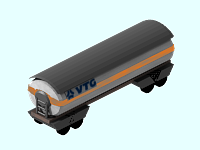The real specifications for this vehicle are (taken from the Wikipedia):
- Units built: 107 trainsets
- Formation: 10 cars (2 heads + 8 cars)
- Total length: 200 m
- Total weight: 385 t
- Top speed: 270 Km/h (later upgraded to 300 Km/h)
- Power output: 6450 kW
This is a blender rendered output (click to enlarge) using its original colour scheme, and some in-game screenshots:
Simutrans object data:
| Type | Electric Locomotive | |
|---|---|---|
| Name | TGV PSE | TGV PSE Car |
| Freight | Passengers | |
| Capacity | 0 | 44 |
| Power | 3225 kW | 0 kW |
| Max.Speed | 270 Km/h | |
| Intro Year | 1981 | |
| Retire Year | N/A | |
The train has been coded into simutrans as the original sets, with a maximum speed of 270 Km/h and 6450 kW of power. They are available from 1981 and the optimum in-game formation is 2 power cars and 4 or 6 passenger cars.
This train is meant to be part of a full TGV pakset, which I hope it will be released soon.
For more information on this locomotive check the following links:




























